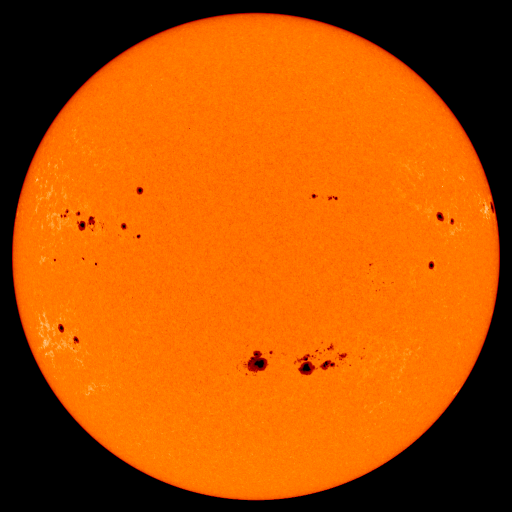sunspots
SUNSPOTS ARE DARK, roughly circular features on the solar photosphere. They appear dark because they are cooler than surrounding parts of the photosphere— 7,000 degrees F (4,000 degrees C) as compared to 11,000 degrees F (6,000 degrees C). Most sunspots are about 20,000 mi (32,000 km) across, wider than the Earth's diameter, with a dark central umbra and a lighter penumbra.
Sunspots form in pairs with opposing magnetic polarities lying in an east-west orientation. Spots in the sun's northern hemisphere have the opposite polarity of spots in the south. For instance, if spot pairs in the northern solar hemisphere have their north-seeking spot to the east, pairs in the southern solar hemisphere will have their north-seeking spot to the west.

Sunspots follow recognizable cycles, in which they form at progressively lower latitudes. Sunspots in any given cycle show a polarity pattern opposite of the sunspots in the previous cycle. However, when one cycle is giving way to the next, it is possible to find spot pairs characteristic of the old cycle still forming near the solar equator while spot pairs characteristic of the new cycle begin forming near the poles.
The primary cycle of rising and falling sunspot activity lasts 11 years, but astronomers have detected larger cycles of peaks and valleys in sunspot activity. Roughly every 70 years, there is a period known as the Maunder minimum in which the sun produces almost no sunspots.
Sunspots are effectively magnetic “storms” and are believed to be formed because the sun's extremely powerful magnetic field becomes twisted because various latitudes rotate at different speeds. Lines of force in the solar magnetic field form bundles of tubes beneath the surface, but where they are kinked by rotational forces, sections are forced to the surface, forming pairs of sunspots.
Because sunspots produce large quantities of charged particles that spew out into the solar system, they have effects on and around the Earth. Satellites have had their electronics burned out by the sudden influx of charged particles. Because the atmosphere expands as it is heated by these charged particles, low-orbiting satellites can be slowed enough to be lost. Charged particles also change the altitude and intensity of the Kennelly-Heavyside layer in the ionosphere, interfering with radio transmissions in the AM broadcast and citizen's band (CB) frequencies, and can even damage ground-based electronics. The first recorded incident occurred in 1859, when sunspot activity shut down telegraph communications in FRANCE.
Sunspots are also responsible for the auroras, the northern and southern lights. During periods of high sunspot activities, the residents of such northern cities as SAINT PETERSBURG, RUSSIA, and Anchorage, ALASKA, are treated to curtains of colored light that shimmer and dance across the nighttime sky.